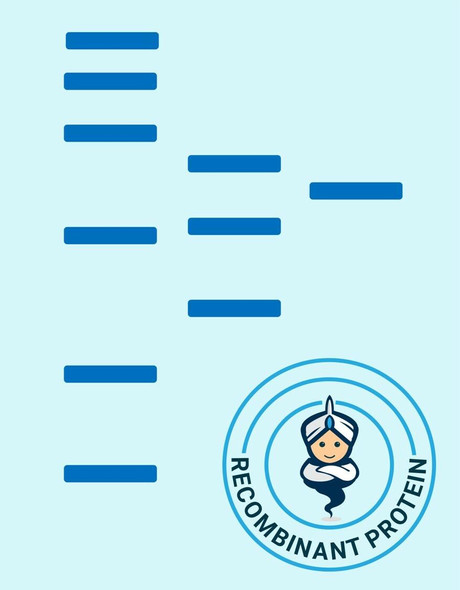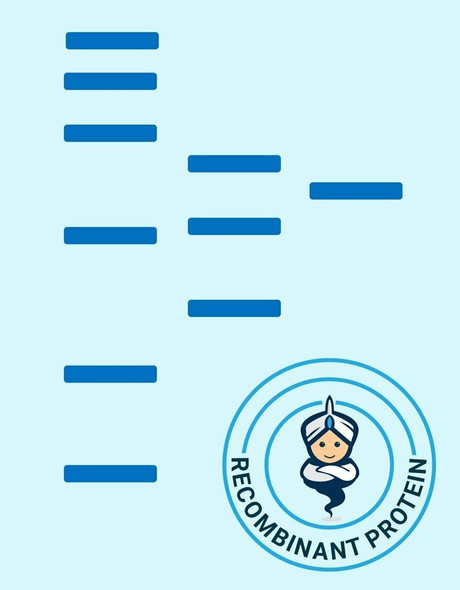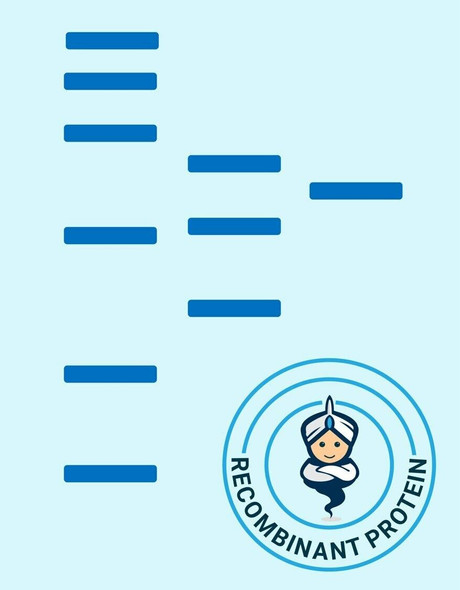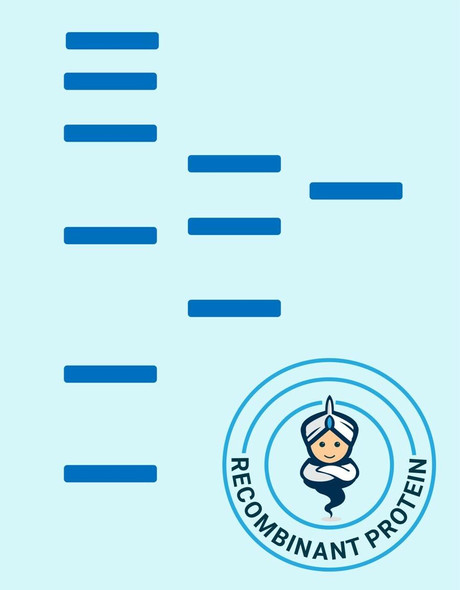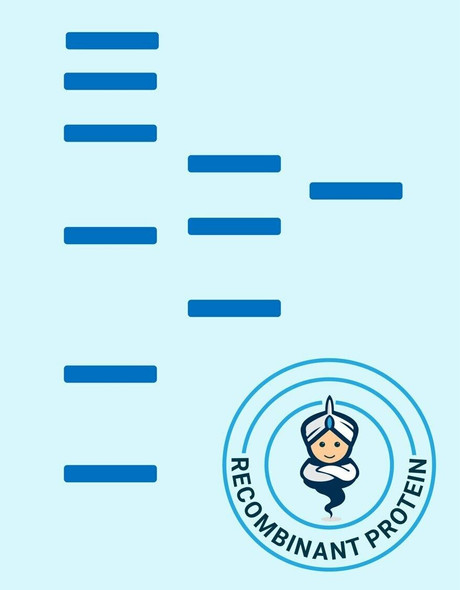Human TNFRSF14 Recombinant Protein (RPPB1033)
- SKU:
- RPPB1033
- Product type:
- Recombinant Protein
- Size:
- 100ug
- Species:
- Human
- Target:
- TNFRSF14
- Synonyms:
- Tumor Necrosis Factor Receptor Superfamily Member 14
- HVEM
- TR2
- Herpes Virus Entry Mediator A
- Source:
- Pichia Pastoris
- Uniprot:
- O43557
Description
| Product Name: | Human TNFRSF14 Recombinant Protein |
| Product Code: | RPPB1033 |
| Size: | 100µg |
| Species: | Human |
| Target: | TNFRSF14 |
| Synonyms: | Tumor Necrosis Factor Receptor Superfamily Member 14, HVEM, TR2, Herpes Virus Entry Mediator A, Tumor Necrosis Factor Receptor-Like 2, Herpesvirus Entry Mediator, HVEA, ATAR, CD270, LIGHTR, CD40-Like Protein, Tumor Necrosis Factor Receptor-Like Gene2. |
| Source: | Pichia Pastoris |
| Physical Appearance: | Sterile Filtered White lyophilized (freeze-dried) powder. |
| Formulation: | TNFRSF14 protein was lyophilized from a 0.2 µm filtered concentrated solution in PBS, pH7.4, with 3 % Trehalose. |
| Solubility: | It is recommended to reconstitute the lyophilized TNFRSF14 in sterile 18M?-cm H2O not less than 100µg/ml, which can then be further diluted to other aqueous solutions. |
| Stability: | Lyophilized TNFRSF14 although stable at room temperature for 3 weeks, should be stored desiccated below -18°C. Upon reconstitution TNFRSF14 should be stored at 4°C between 2-7 days and for future use below -18°C. For long term storage it is recommended to add a carrier protein (0.1% HSA or BSA). Please prevent freeze-thaw cycles. |
| Purity: | Greater than 95.0% as determined by: (a) Analysis by RP-HPLC.(b) Analysis by SDS-PAGE. |
| Amino Acid Sequence: | LPSCKEDEYP VGSECCPKCS PGYRVKEACG ELTGTVCEPC PPGTYIAHLN GLSKCLQCQM CDPAMGLRAS RNCSRTENAV CGCSPGHFCI VQDGDHCAAC RAYATSSPGQ RVQKGGTESQ DTLCQNCPPG TFSPNGTLEE CQHQTKCSWL VTKAGAGTSS SHWVEPKSSD KTHTCPPCPA PEFEGAPSVF LFPPKPKDTL MISRTPEVTC VVVDVSHEDP EVKFNWYVDG VEVHNAKTKP REEQYNSTYR VVSVLTVLHQ DWLNGKEYKC KVSNKALPTP IEKTISKAKG QPREPQVYTL PPSRDELTKN QVSLTCLVKG FYPSDIAVEW ESNGQPENNY KTTPPVLDSD GSFFLYSKLT VDKSRWQQGN VFSCSVMHEA LHNHYTQKSL SLSPGK |
| Biological Activity: | Fully biologically active when compared to standard. The biologically active as determined by its ability to inhibit TNF-beta -mediated cytotoxicity using murine L929 cells. |
TNFRSF14, a member of the TNF receptor superfamily, is a type I transmembrane protein. TNFRSF14 is expressed in peripheral blood T cells, B cells, monocytes and in various tissues enriched in lymphoid cells. TNFRSF14 operates as a co-stimulatory factor for the activation of lymphoid cells and as a deterrent to infection by herpesvirus. Additionally, TNFRSF14 encourages the proliferation of T cells, and triggers apoptosis of various tumor cells.
TNFRSF14 Human Recombinant produced in Pichia Pastoris is a single, glycosylated, polypeptide chain containing 396 amino acids and having a molecular mass of 58.0kDa. However, TNFRSF14 migrates with an apparent molecular mass of 70 kDa in SDS-PAGE under reducing conditions.
| UniProt Protein Function: | TNFSF14: Cytokine that binds to TNFRSF3/LTBR. Binding to the decoy receptor TNFRSF6B modulates its effects. Activates NFKB, stimulates the proliferation of T-cells, and inhibits growth of the adenocarcinoma HT-29. Acts as a receptor for Herpes simplex virus. Belongs to the tumor necrosis factor family. 2 isoforms of the human protein are produced by alternative splicing. |
| UniProt Protein Details: | Protein type:Membrane protein, integral; Cytokine; Inhibitor Chromosomal Location of Human Ortholog: 19p13.3 Cellular Component: extracellular space; cytoplasm; plasma membrane; integral to membrane Molecular Function:protein binding; caspase inhibitor activity; cytokine activity; tumor necrosis factor receptor binding; receptor binding Biological Process: release of cytoplasmic sequestered NF-kappaB; T cell proliferation; T cell activation; apoptosis; T cell costimulation; T cell homeostasis; immune response; negative regulation of caspase activity; signal transduction; positive regulation of myoblast differentiation |
| NCBI Summary: | The protein encoded by this gene is a member of the tumor necrosis factor (TNF) ligand family. This protein is a ligand for TNFRSF14, which is a member of the tumor necrosis factor receptor superfamily, and which is also known as a herpesvirus entry mediator (HVEM). This protein may function as a costimulatory factor for the activation of lymphoid cells and as a deterrent to infection by herpesvirus. This protein has been shown to stimulate the proliferation of T cells, and trigger apoptosis of various tumor cells. This protein is also reported to prevent tumor necrosis factor alpha mediated apoptosis in primary hepatocyte. Two alternatively spliced transcript variant encoding distinct isoforms have been reported. [provided by RefSeq, Jul 2008] |
| UniProt Code: | O43557 |
| NCBI GenInfo Identifier: | 313104028 |
| NCBI Gene ID: | 8740 |
| NCBI Accession: | O43557.2 |
| UniProt Secondary Accession: | O43557,O75476, Q6FHA1, Q8WVF8, Q96LD2, A8K7M2, C9J5H4 |
| UniProt Related Accession: | O43557 |
| Molecular Weight: | 22,395 Da |
| NCBI Full Name: | Tumor necrosis factor ligand superfamily member 14 |
| NCBI Synonym Full Names: | tumor necrosis factor (ligand) superfamily, member 14 |
| NCBI Official Symbol: | TNFSF14 |
| NCBI Official Synonym Symbols: | LTg; TR2; CD258; HVEML; LIGHT |
| NCBI Protein Information: | tumor necrosis factor ligand superfamily member 14; delta transmembrane LIGHT; herpesvirus entry mediator A; herpesvirus entry mediator ligand; herpesvirus entry mediator-ligand; herpes virus entry mediator ligand; ligand for herpesvirus entry mediator; tumor necrosis factor receptor-like 2; tumor necrosis factor superfamily member LIGHT |
| UniProt Protein Name: | Tumor necrosis factor ligand superfamily member 14 |
| UniProt Synonym Protein Names: | Herpes virus entry mediator ligand; HVEM-L; Herpesvirus entry mediator ligand; CD_antigen: CD258Cleaved into the following 2 chains:Tumor necrosis factor ligand superfamily member 14, membrane form; Tumor necrosis factor ligand superfamily member 14, soluble form |
| Protein Family: | Light-induced protein |
| UniProt Gene Name: | TNFSF14 |
| UniProt Entry Name: | TNF14_HUMAN |



